2013 Peugeot 508 Hybrid display
[x] Cancel search: displayPage 127 of 340
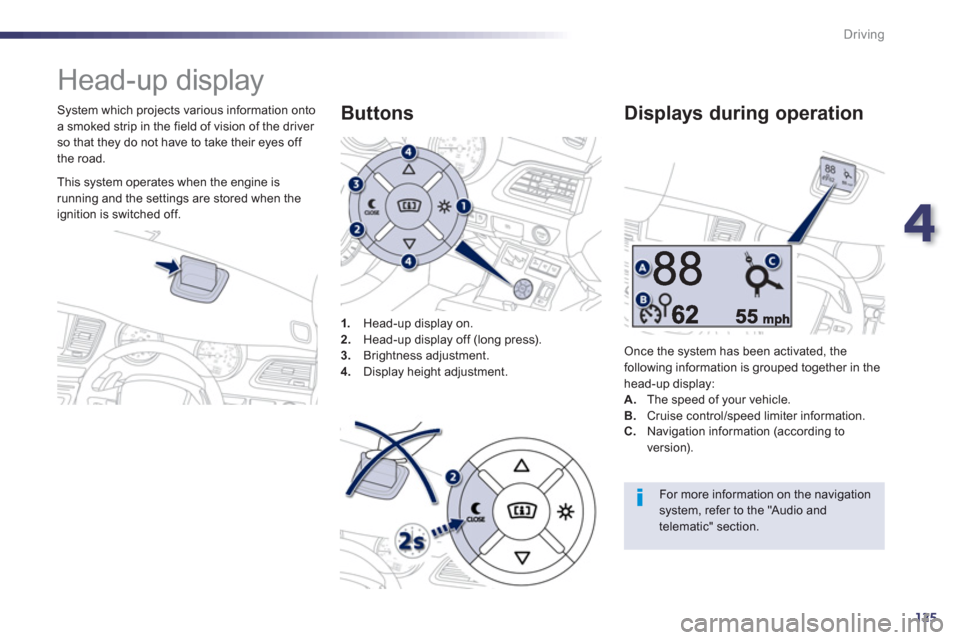
4
125
Driving
Head-up display
System which projects various information onto
a smoked strip in the field of vision of the driver so that they do not have to take their eyes off
the road.
1
.Head-up display on. 2. Head-up display off (long press).3.
Brightness adjustment. 4.
Display height adjustment.
Buttons
Once the system has been activated, thefollowing information is grouped together in the
head-up display:A.The speed of your vehicle. B. Cruise control/speed limiter information.
Displays during operation
C.
Navigation information (according to
version).
For more information on the navigation system, refer to the "Audio andtelematic" section.
This system operates when the engine is
running and the settings are stored when the
i
gnition is switched off.
Page 128 of 340
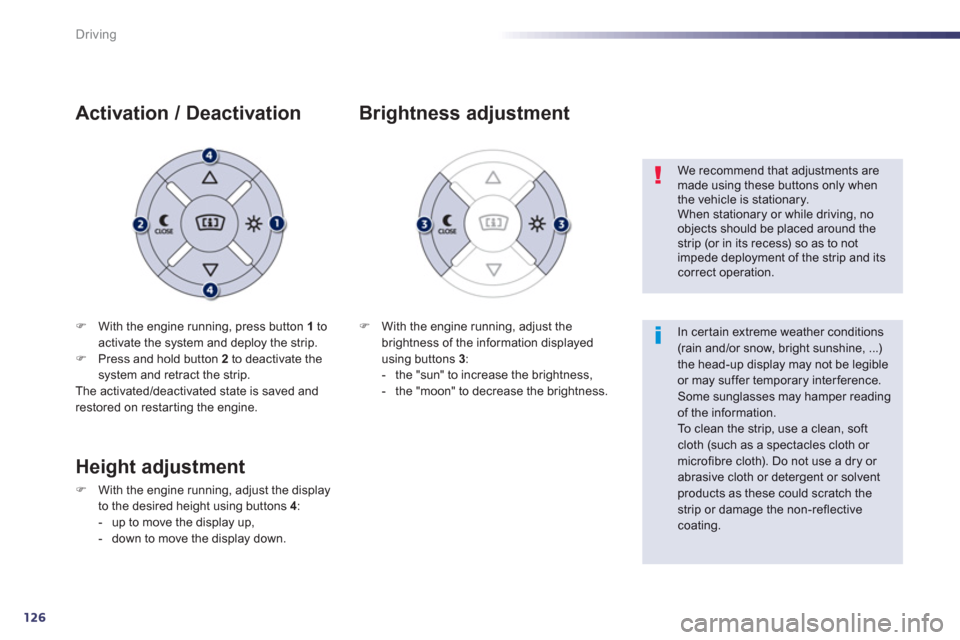
126
Driving
FWith the engine running, press button 1 toactivate the system and deploy the strip. FPress and hold button 2
to deactivate the
system and retract the strip.
The activated/deactivated state is saved and restored on restar ting the engine.
Activation / Deactivation
F With the engine running, adjust the
brightness of the information displayedusing buttons 3 :
- the "sun" to increase the brightness,
- the "moon" to decrease the brightness.
Brightness adjustment
We recommend that adjustments aremade using these buttons only whenthe vehicle is stationary.
When stationary or while driving, noobjects should be placed around thestrip (or in its recess) so as to not impede deployment of the strip and itscorrect operation.
In certain extreme weather conditions (rain and/or snow, bright sunshine, ...) the head-up display may not be legibleor may suffer temporary interference. Some sunglasses may hamper readingof the information.
To clean the strip, use a clean, soft cloth (such as a spectacles cloth or microfibre cloth). Do not use a dry or abrasive cloth or detergent or solventproducts as these could scratch thestrip or damage the non-reflectivecoating.
Height adjustment
FWith the engine running, adjust the display
to the desired height using buttons 4 :
- up to move the display up,
- down to move the display down.
Page 129 of 340
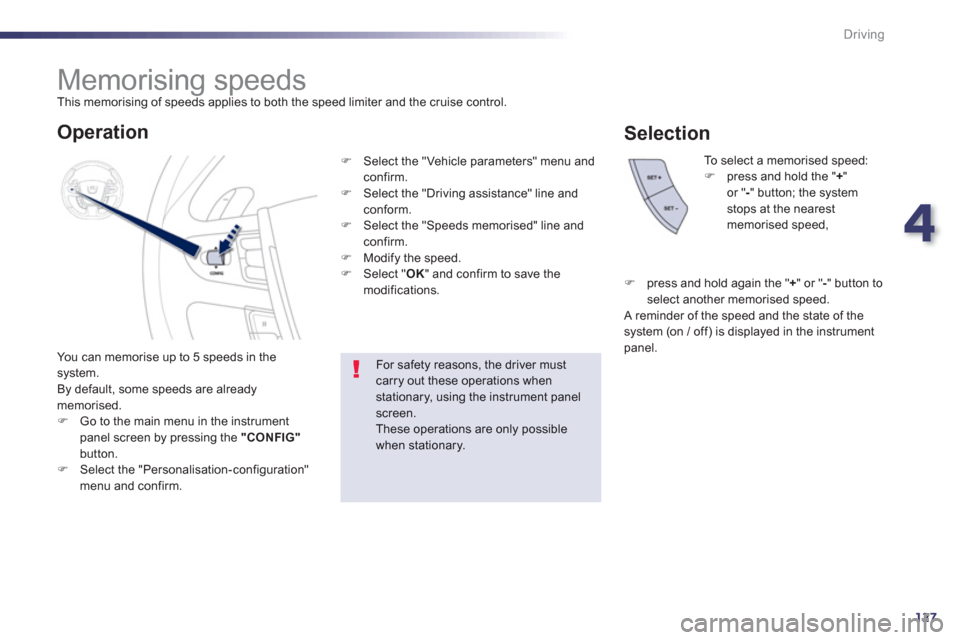
4
127
Driving
Memorising speeds
This memorising of speeds applies to both the speed limiter and the cruise control.
You can memorise u
p to 5 speeds in the system.
By default, some speeds are already memorised.FGo to the main menu in the instrument
panel screen by pressing the "CONFIG"button.FSelect the "Personalisation-configuration" menu and confirm.
To select a memorised speed:Fpress and hold the "+"or " -" button; the systemstops at the nearest memorised speed,
For safety reasons, the driver mustcarry out these operations when stationary, using the instrument panel screen.These operations are only possible when stationary.
Operation
FSelect the "Vehicle parameters" menu andconfirm.FSelect the "Driving assistance" line and conform.
FSelect the "Speeds memorised" line andconfirm.FModify the speed. FSelect " OK" and confirm to save the
modifications.
Selection
F
press and hold again the "+ " or " - " button toselect another memorised speed.
A reminder of the speed and the state of thesystem (on / off) is displayed in the instrument
panel.
Page 130 of 340
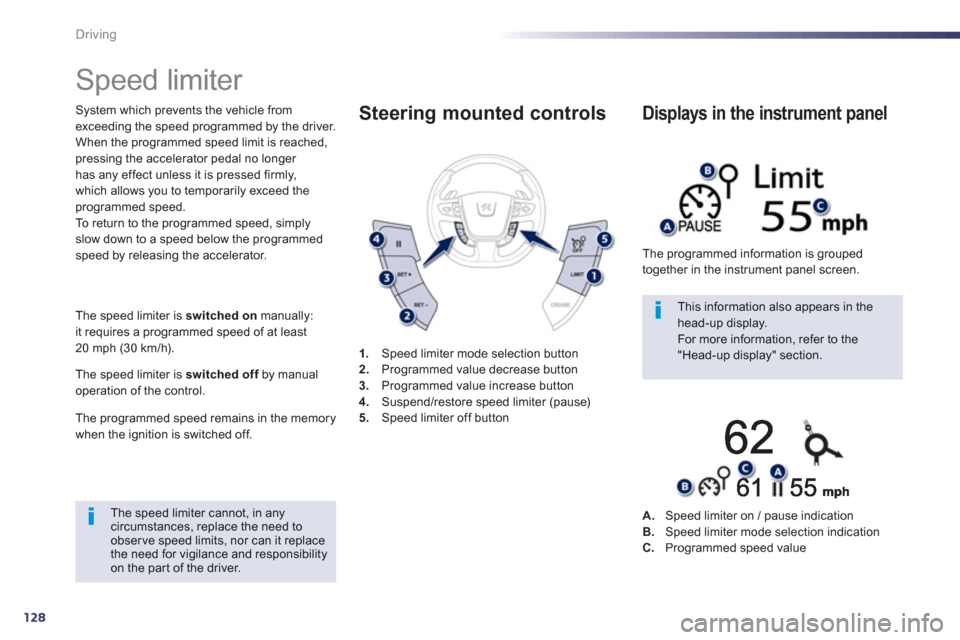
128
Driving
Speed limiter
System which prevents the vehicle fromexceeding the speed programmed by the driver.
When the programmed speed limit is reached,
pressing the accelerator pedal no longer has any effect unless it is pressed firmly,
which allows you to temporarily exceed theprogrammed speed.
To return to the programmed speed, simply
slow down to a speed below the programmed speed by releasing the accelerator.
The speed limiter is switched onmanuall
y:
it requires a programmed speed of at least
20 mph (30 km/h).
The speed limiter is
switched off by manual foperation of the control.
The pro
grammed speed remains in the memorywhen the ignition is switched off.
The speed limiter cannot, in anycircumstances, replace the need to obser ve speed limits, nor can it replacethe need for vigilance and responsibility on the par t of the driver.
This information also appears in the head-up display.
For more information, refer to the "Head-up display" section. 1.Speed limiter mode selection button
2. Programmed value decrease button3.
Programmed value increase button4.Suspend/restore speed limiter (pause)5.Speed limiter off button
Steering mounted controls
The programmed information is grouped
together in the instrument panel screen.
Displays in the instrument panel
A.Speed limiter on / pause indicationB.Speed limiter mode selection indicationC.Programmed speed value
Page 131 of 340
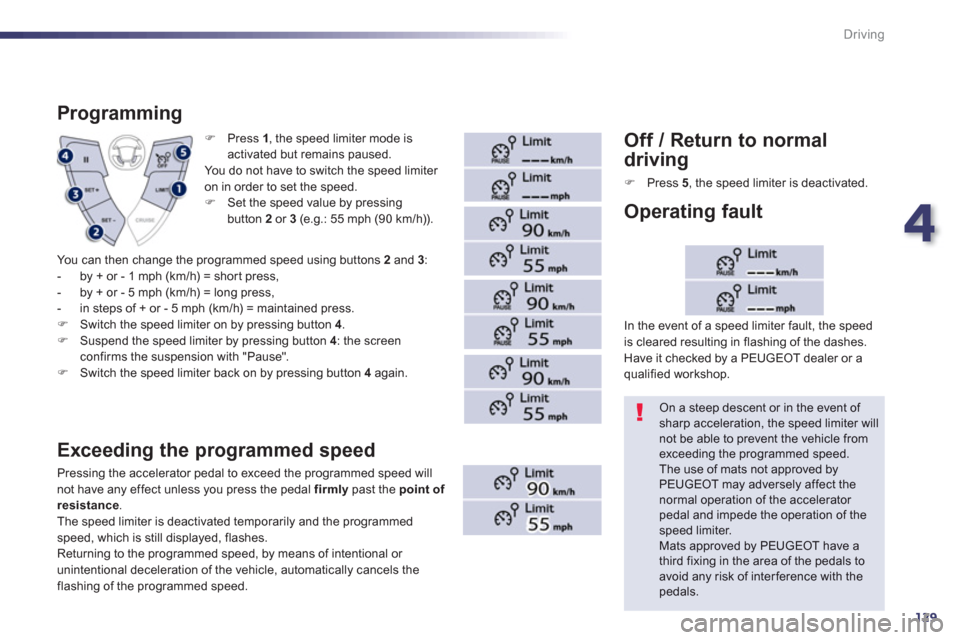
4
129
Driving
F Press 1, the speed limiter mode is
activated but remains paused.
You do not have to switch the s
peed limiter
on in order to set the speed. F Set the speed value by pressingbutton 2or 3(e.g.: 55 mph (90 km/h)).
Programming
Exceeding the programmed speed
Pressing the accelerator pedal to exceed the programmed speed will not have any effect unless you press the pedal firmlypast the point of resistance.
The speed limiter is deactivated temporarily and the programmedspeed, which is still displayed, flashes.
Returning to the programmed speed, by means of intentional or
unintentional deceleration of the vehicle, automatically cancels the
flashing of the programmed speed.
Off / Return to normal
driving
F
Press 5, the speed limiter is deactivated.
On a steep descent or in the event of sharp acceleration, the speed limiter willnot be able to prevent the vehicle from exceeding the programmed speed.
The use of mats not approved byPEUGEOT may adversely affect the normal operation of the accelerator pedal and impede the operation of thespeed limiter.
Mats approved by PEUGEOT have a third fixing in the area of the pedals to avoid any risk of interference with thepedals.
In the event o
f a speed limiter fault, the speed
is cleared resulting in flashing of the dashes.
Have it checked by a PEUGEOT dealer or a qualified workshop.
Operating fault
You can then change the programmed speed using buttons 2
and 3:
- by + or - 1 mph (km/h) = shor t press,
- by + or - 5 mph (km/h) = long press,
- in steps of + or - 5 mph (km/h) = maintained press. FSwitch the speed limiter on by pressing button 4 . FSuspend the speed limiter by pressing button 4: the screen confirms the suspension with "Pause".FSwitch the speed limiter back on by pressing button 4
again.
Page 132 of 340
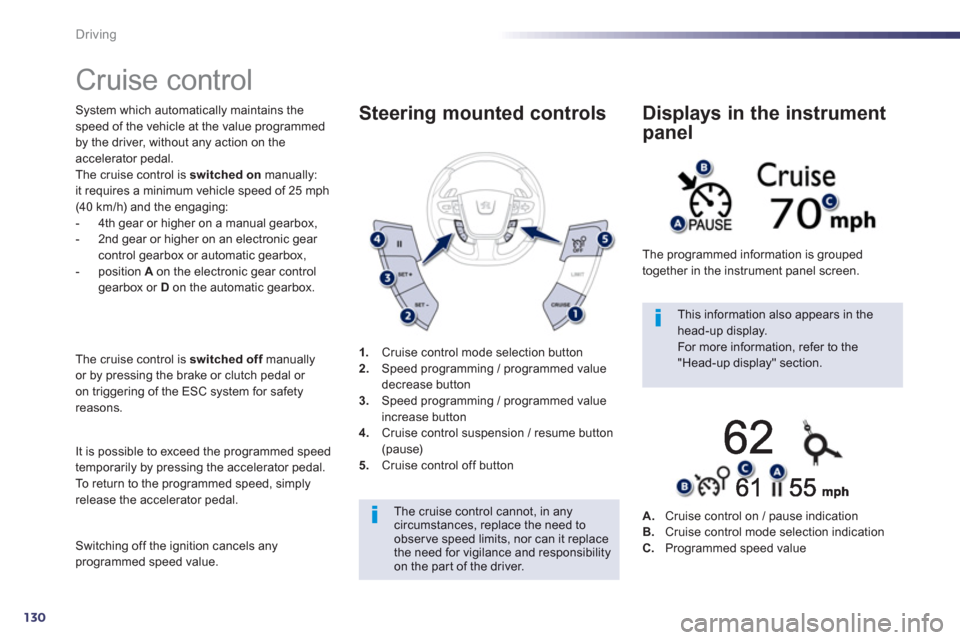
130
Driving
Cruise control
System which automatically maintains thespeed of the vehicle at the value programmed
by the driver, without any action on the
accelerator pedal. The cruise control is switched on
manually:
it requires a minimum vehicle speed of 25 mph(40 km/h) and the engaging:
- 4th gear or higher on a manual gearbox,
- 2nd
gear or higher on an electronic gear control gearbox or automatic gearbox,
- position A
on the electronic gear control gearbox or Don the automatic gearbox.
Th
e cruise control is switched offmanuallyfor by pressing the brake or clutch pedal or
on triggering of the ESC system for safety reasons.
It is possible to exceed the programmed speed
temporarily by pressing the accelerator pedal. To return to the programmed speed, simply release the accelerator pedal.
Switching off the ignition cancels any programmed speed value. 1
.Cruise control mode selection button
2. Speed programming / programmed value decrease button 3.
Speed programming / programmed value
increase button 4.Cruise control suspension / resume button (pause)5.Cruise control off button
Steering mounted controls
The cruise control cannot, in anycircumstances, replace the need to observe speed limits, nor can it replace the need for vigilance and responsibilityon the par t of the driver.
This information also appears in the head-up display.
For more information, refer to the "Head-up display" section. The pro
grammed information is grouped
together in the instrument panel screen.
Displays in the instrument
panel
A.Cruise control on / pause indicationB.Cruise control mode selection indication
C.Programmed speed value
Page 133 of 340
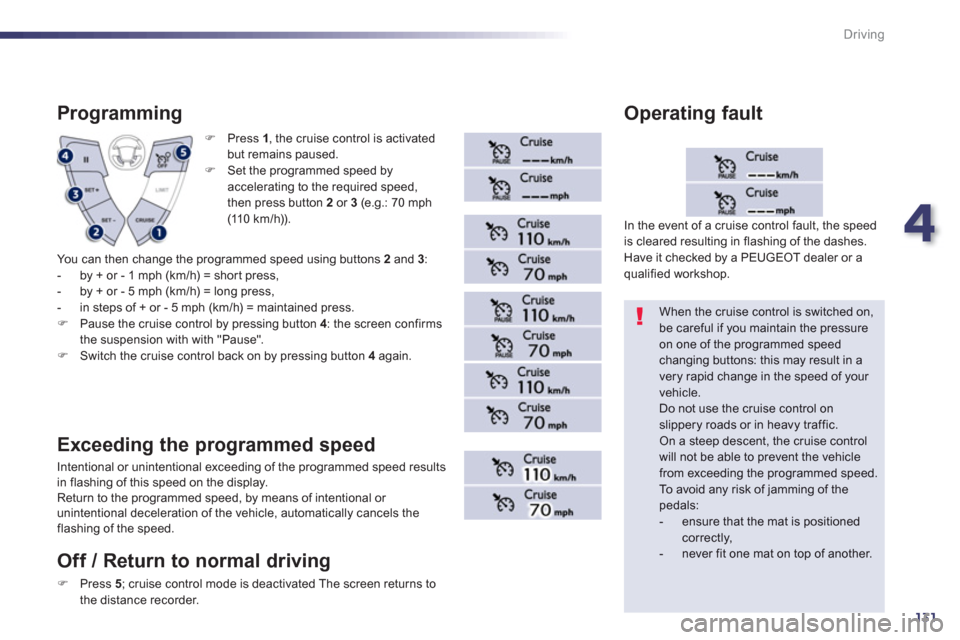
4
131
Driving
F Press 1, the cruise control is activated but remains paused.F
Set the programmed speed by
accelerating to the required speed,
then press button 2or 3(e.g.: 70 mph (11 0 k m / h)).
Programming
You can then change the programmed speed using buttons 2
and 3
:
- by + or - 1 mph (km/h) = shor t press,
- by + or - 5 mph (km/h) = long press,
- in steps of + or - 5 mph (km/h) = maintained press. FPause the cruise control by pressing button 4
: the screen confirmsthe suspension with with "Pause".FSwitch the cruise control back on by pressing button 4again.
Exceeding the programmed speed
Intentional or unintentional exceeding of the programmed speed results
in flashing of this speed on the display.
Return to the programmed speed, by means of intentional or
unintentional deceleration of the vehicle, automatically cancels theflashing of the speed.
When the cruise control is switched on,be careful if you maintain the pressure on one of the programmed speedchanging buttons: this may result in avery rapid change in the speed of your vehicle. Do not use the cruise control on slippery roads or in heavy traffic.
On a steep descent, the cruise control will not be able to prevent the vehicle from exceeding the programmed speed.
To avoid any risk of jamming of the pedals:
- ensure that the mat is positioned correctly,
- never fit one mat on top of another.
In the event o
f a cruise control fault, the speed
is cleared resulting in flashing of the dashes.
Have it checked by a PEUGEOT dealer or a qualified workshop.
Operating fault
Off / Return to normal drivin
g
FPress 5
; cruise control mode is deactivated The screen returns to
the distance recorder.
Page 134 of 340
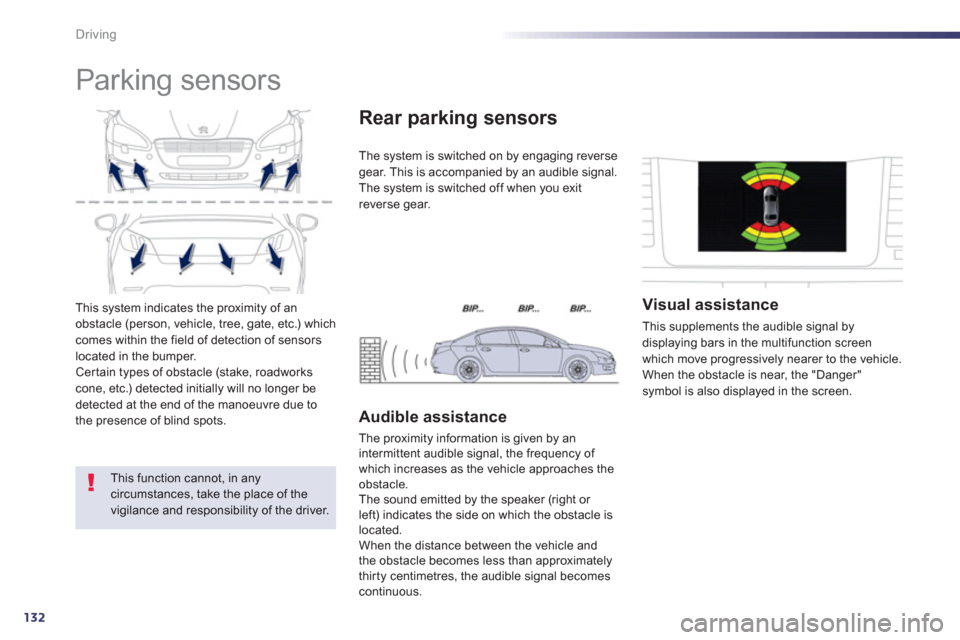
132
Driving
This system indicates the proximity of an
obstacle (person, vehicle, tree, gate, etc.) which comes within the field of detection of sensorslocated in the bumper.Certain types of obstacle (stake, roadworks cone, etc.) detected initially will no longer be detected at the end of the manoeuvre due to
the presence of blind spots.
Parking sensors
This function cannot, in any circumstances, take the place of the vigilance and responsibility of the driver.
The system is switched on by engaging reverse
gear. This is accompanied by an audible signal.
The s
ystem is switched off when you exit reverse gear.
Rear parking sensors
Audible assistance
The proximity information is given by an
intermittent audible signal, the frequency of
which increases as the vehicle approaches the
obstacle.
The sound emitted by the speaker (right or left) indicates the side on which the obstacle is located.
When the distance between the vehicle andthe obstacle becomes less than approximatelythirty centimetres, the audible signal becomes continuous.
Visual assistance
This supplements the audible signal by
displaying bars in the multifunction screen
which move progressively nearer to the vehicle.
When the obstacle is near, the "Danger"symbol is also displayed in the screen.